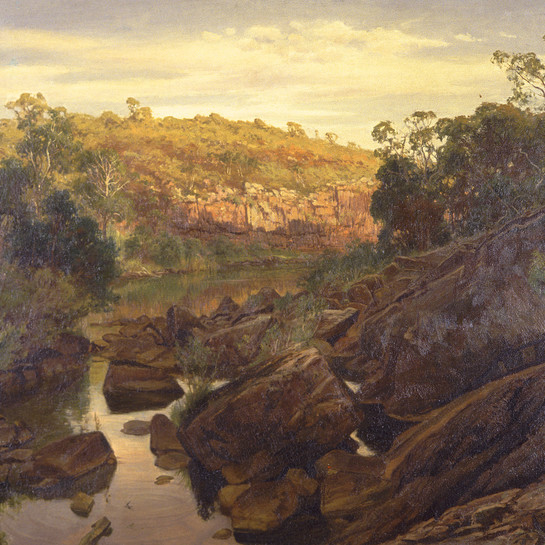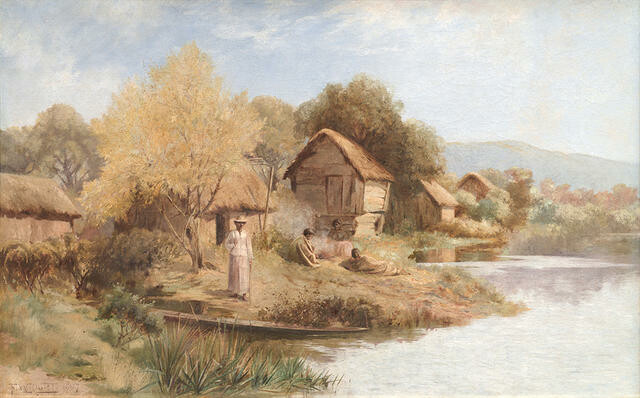Frank Wright
Aotearoa New Zealand / British, b.1860, d.1923
Native Village By A Lake
- 1897
- Oil on canvas
- Purchased, 1991
- 900 x 1350 x 45mm
- 91/48
Tags: boats, buildings (structures), hills, houses, lakes (bodies of water), landscapes (representations), Māori (culture or style), people (agents), trees
Frank Wright had a deep interest in nature and painting scenes of Māori life. However, he did not always offer accurate representations, tending towards the serene aspects of late nineteenth-century Māori life while the colonial reality was quite different. Wright’s autumnal sunlight washes this village scene in warm amber tones. A woman in powdery pink and white provides an anchoring presence in the landscape, gazing back at the viewer with fellow villagers seated behind her.
(Endless Light, 29 June 2019 – 8 March 2020)
Exhibition History
This is thought to be a village on the banks of the Waikato River, an area Frank and his brother, Walter, visited regularly. Scenes of Maori life were a popular subject with many New Zealand artists at the time. Native Village by a Lake is a studio work which would have been developed from studies and sketches made out of doors. Frank and Walter often worked closely together and went on sketching trips in the Auckland, Waikato and Urewera regions. Walter would often put finishing touches to figures that Frank included in his landscapes. Wright was born in Nottingham and studied at the South Kensington School of Art in London. In 1877 he emigrated to New Zealand with his mother and younger brother, Walter. The brothers shared a studio in Victoria Arcade, Auckland. Another notable tenant in the building was C.F. Goldie. Wright was also a competent musician and a member of the Waiata Quartet. He exhibited with the Auckland Society of Arts from 1885 to 1923.
(Label date unknown)
By 1897 the painter of this work who was English born and trained had set up a studio with his younger brother Walter in Auckland’s Victoria Arcade. Other tenants in the building included Louis J. Steele, C. F. Goldie, and Kennett Watkins. All had an interest in painting scenes of Maori life as they saw it but this was not particularly accurate.
Frank and Walter Wright worked closely together and often went on sketching trips in the Auckland province and Urewera country. Walter would often put finishing touches to figures that Frank included in his landscapes.
Frank Wright was largely a landscape painter who worked a great deal in the watercolour medium and only occasionally in oils. His view of the Maori was a popular one at the time among many artists, that is they were depicted in picturesque genre scenes engaged in everyday tasks. This was similar to the depiction of European peasants by the nineteenth century Realist school. The Maori appear in this work in a scene of quaint rustic charm in European dress.
This is a studio-work which may have had its inspiration in studies Frank Wright made of a village and trees on the banks of the Waikato river.
(Label date unknown)

